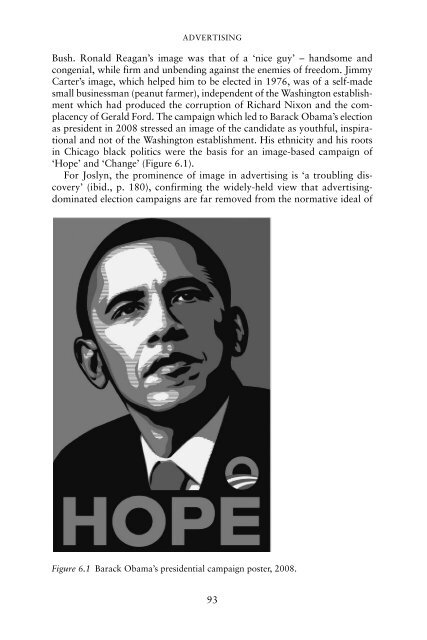- Page 2 and 3:
AN INTRODUCTION TO POLITICAL COMMUN
- Page 4 and 5:
GETTING THE MESSAGE News, truth and
- Page 6:
AN INTRODUCTION TO POLITICAL COMMUN
- Page 9 and 10:
First published 1995 by Routledge S
- Page 11 and 12:
FOR RAYMOND AND JANINE
- Page 13 and 14:
CONTENTS 10 Conclusion: performance
- Page 15 and 16:
PREFACE AND ACKNOWLEDGEMENTS In his
- Page 17 and 18:
PREFACE AND ACKNOWLEDGEMENTS produc
- Page 19 and 20:
PREFACE TO THE FIFTH EDITION democr
- Page 22:
Part I POLITICS IN THE AGE OF MEDIA
- Page 25 and 26:
POLITICS IN THE AGE OF MEDIATION em
- Page 27 and 28:
POLITICS IN THE AGE OF MEDIATION Fi
- Page 29 and 30:
POLITICS IN THE AGE OF MEDIATION si
- Page 31 and 32:
POLITICS IN THE AGE OF MEDIATION Th
- Page 33 and 34:
POLITICS IN THE AGE OF MEDIATION Th
- Page 35 and 36:
POLITICS IN THE AGE OF MEDIATION Re
- Page 37 and 38:
POLITICS IN THE AGE OF MEDIATION th
- Page 39 and 40:
POLITICS IN THE AGE OF MEDIATION th
- Page 41 and 42:
POLITICS IN THE AGE OF MEDIATION sc
- Page 43 and 44:
POLITICS IN THE AGE OF MEDIATION an
- Page 45 and 46:
POLITICS IN THE AGE OF MEDIATION is
- Page 47 and 48:
POLITICS IN THE AGE OF MEDIATION Fu
- Page 49 and 50:
POLITICS IN THE AGE OF MEDIATION ME
- Page 51 and 52:
POLITICS IN THE AGE OF MEDIATION ex
- Page 53 and 54:
POLITICS IN THE AGE OF MEDIATION th
- Page 55 and 56:
POLITICS IN THE AGE OF MEDIATION of
- Page 57 and 58:
POLITICS IN THE AGE OF MEDIATION pu
- Page 59 and 60:
POLITICS IN THE AGE OF MEDIATION po
- Page 61 and 62:
POLITICS IN THE AGE OF MEDIATION mo
- Page 63 and 64: POLITICS IN THE AGE OF MEDIATION th
- Page 65 and 66: POLITICS IN THE AGE OF MEDIATION TH
- Page 67 and 68: POLITICS IN THE AGE OF MEDIATION Th
- Page 69 and 70: POLITICS IN THE AGE OF MEDIATION Ch
- Page 71 and 72: POLITICS IN THE AGE OF MEDIATION
- Page 73 and 74: POLITICS IN THE AGE OF MEDIATION th
- Page 75 and 76: Table 4.2 Party political affiliati
- Page 77 and 78: POLITICS IN THE AGE OF MEDIATION th
- Page 79 and 80: POLITICS IN THE AGE OF MEDIATION ma
- Page 81 and 82: POLITICS IN THE AGE OF MEDIATION al
- Page 83 and 84: POLITICS IN THE AGE OF MEDIATION so
- Page 85 and 86: POLITICS IN THE AGE OF MEDIATION an
- Page 87 and 88: POLITICS IN THE AGE OF MEDIATION Fu
- Page 89 and 90: POLITICS IN THE AGE OF MEDIATION bu
- Page 91 and 92: POLITICS IN THE AGE OF MEDIATION th
- Page 93 and 94: POLITICS IN THE AGE OF MEDIATION to
- Page 95 and 96: POLITICS IN THE AGE OF MEDIATION jo
- Page 97 and 98: POLITICS IN THE AGE OF MEDIATION Br
- Page 99 and 100: POLITICS IN THE AGE OF MEDIATION in
- Page 101 and 102: POLITICS IN THE AGE OF MEDIATION to
- Page 103 and 104: POLITICS IN THE AGE OF MEDIATION el
- Page 106 and 107: 6 PARTY POLITICAL COMMUNICATION I A
- Page 108 and 109: ADVERTISING controls the encoding o
- Page 110 and 111: ADVERTISING margarine is more than
- Page 112 and 113: ADVERTISING Political advertising i
- Page 116 and 117: ADVERTISING The manifest emotionali
- Page 118 and 119: ADVERTISING Another negative spot b
- Page 120 and 121: ADVERTISING worlds of politics, ent
- Page 122 and 123: ADVERTISING government of Harold Ma
- Page 124 and 125: ADVERTISING the qualitative researc
- Page 126 and 127: ADVERTISING obsession with the medi
- Page 128 and 129: ADVERTISING Figure 6.4 Labour’s p
- Page 130 and 131: ADVERTISING presentation in politic
- Page 132 and 133: ADVERTISING concerned about losing
- Page 134 and 135: ADVERTISING remained unsympathetic
- Page 136 and 137: ADVERTISING ‘simplistic dualities
- Page 138 and 139: ADVERTISING process in general), an
- Page 140 and 141: POLITICAL PUBLIC RELATIONS Gaining
- Page 142 and 143: POLITICAL PUBLIC RELATIONS disaster
- Page 144 and 145: POLITICAL PUBLIC RELATIONS for tran
- Page 146 and 147: POLITICAL PUBLIC RELATIONS of polic
- Page 148 and 149: POLITICAL PUBLIC RELATIONS Figure 7
- Page 150 and 151: POLITICAL PUBLIC RELATIONS traditio
- Page 152 and 153: POLITICAL PUBLIC RELATIONS advertis
- Page 154 and 155: POLITICAL PUBLIC RELATIONS At news
- Page 156 and 157: POLITICAL PUBLIC RELATIONS the medi
- Page 158 and 159: POLITICAL PUBLIC RELATIONS Many of
- Page 160 and 161: POLITICAL PUBLIC RELATIONS the publ
- Page 162 and 163: POLITICAL PUBLIC RELATIONS be more
- Page 164 and 165:
POLITICAL PUBLIC RELATIONS the Cons
- Page 166 and 167:
POLITICAL PUBLIC RELATIONS a matter
- Page 168 and 169:
POLITICAL PUBLIC RELATIONS series o
- Page 170 and 171:
POLITICAL PUBLIC RELATIONS nothing
- Page 172 and 173:
8 PRESSURE-GROUP POLITICS AND THE O
- Page 174 and 175:
PRESSURE-GROUP POLITICS by the US p
- Page 176 and 177:
PRESSURE-GROUP POLITICS put an issu
- Page 178 and 179:
PRESSURE-GROUP POLITICS the website
- Page 180 and 181:
PRESSURE-GROUP POLITICS ignoring th
- Page 182 and 183:
PRESSURE-GROUP POLITICS eminently r
- Page 184 and 185:
PRESSURE-GROUP POLITICS Ruddock in
- Page 186 and 187:
PRESSURE-GROUP POLITICS Pressure gr
- Page 188 and 189:
PRESSURE-GROUP POLITICS Among their
- Page 190 and 191:
PRESSURE-GROUP POLITICS a statement
- Page 192 and 193:
PRESSURE-GROUP POLITICS setting up
- Page 194 and 195:
9 POLITICAL COMMUNICATION IN A GLOB
- Page 196 and 197:
POLITICAL COMMUNICATION IN A GLOBAL
- Page 198 and 199:
POLITICAL COMMUNICATION IN A GLOBAL
- Page 200 and 201:
POLITICAL COMMUNICATION IN A GLOBAL
- Page 202 and 203:
POLITICAL COMMUNICATION IN A GLOBAL
- Page 204 and 205:
POLITICAL COMMUNICATION IN A GLOBAL
- Page 206 and 207:
POLITICAL COMMUNICATION IN A GLOBAL
- Page 208 and 209:
POLITICAL COMMUNICATION IN A GLOBAL
- Page 210 and 211:
POLITICAL COMMUNICATION IN A GLOBAL
- Page 212 and 213:
POLITICAL COMMUNICATION IN A GLOBAL
- Page 214 and 215:
POLITICAL COMMUNICATION IN A GLOBAL
- Page 216 and 217:
POLITICAL COMMUNICATION IN A GLOBAL
- Page 218 and 219:
POLITICAL COMMUNICATION IN A GLOBAL
- Page 220 and 221:
POLITICAL COMMUNICATION IN A GLOBAL
- Page 222 and 223:
POLITICAL COMMUNICATION IN A GLOBAL
- Page 224 and 225:
POLITICAL COMMUNICATION IN A GLOBAL
- Page 226 and 227:
CONCLUSION The revolution in the
- Page 228 and 229:
CONCLUSION extent that good politic
- Page 230 and 231:
NOTES 1 POLITICS IN THE AGE OF MEDI
- Page 232 and 233:
NOTES strongly in favour of the Con
- Page 234 and 235:
NOTES 1986; Tilson, 1994). For a de
- Page 236 and 237:
BIBLIOGRAPHY —— The British Gen
- Page 238 and 239:
BIBLIOGRAPHY Graber, D. A., ‘Poli
- Page 240 and 241:
BIBLIOGRAPHY —— ‘Television N
- Page 242 and 243:
BIBLIOGRAPHY Schlesinger, P., Putti
- Page 244 and 245:
INDEX The Alistair Campbell Diaries
- Page 246 and 247:
INDEX Macarthur, J. R. 195-7 MacAsk
















